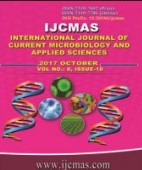


 National Academy of Agricultural Sciences (NAAS)
National Academy of Agricultural Sciences (NAAS)

|
PRINT ISSN : 2319-7692
Online ISSN : 2319-7706 Issues : 12 per year Publisher : Excellent Publishers Email : editorijcmas@gmail.com / submit@ijcmas.com Editor-in-chief: Dr.M.Prakash Index Copernicus ICV 2018: 95.39 NAAS RATING 2020: 5.38 |
Iron (Fe) in the soil is present mostly in the form of insoluble Fe (III) oxides and hydroxides (e.g. haematite, goethite, ferrihydrite). The total iron in soil is much higher than most crops require. Nevertheless, the concentration of free Fe (III) in most agricultural soils is far below that required for optimal plant growth, which is between 10–9 and 10–4 M Fe (III) in the soil solution (Lindsay and Schwab, 1982). Generally, chelation of Fe (III) is the most successful mechanism by which plants roots can acquire Fe. Production of chelating compounds by microorganisms increases Fe solubility in the rhizosphere and hence increases plant Fe acquisition. Bacterial and fungal siderophores and other chelating metabolites are assumed to serve as major sources of plant-available Fe in the rhizosphere. Moreover, from the earlier literature it is well known that microbial chelates produced in the rhizosphere mobilize Fe (III) from insoluble Fe sources. In cultivated soil iron is oxidized to form ferric oxide and oxy hydroxides results in low availability of iron for living organisms. To face the demand of Fe (III) in the rhizosphere leads to strong competition for this nutrient among living organisms, plants and microorganisms have developed active strategies of iron uptake. Efficient siderophores of microbial populations from the rhizosphere do not compete with the plant harboring them, and even seems to contribute to the plant iron nutrition. The complex interaction between soil chemical properties, plants, and microbes affects the iron dynamics in the rhizosphere, which in turn impact the plant health and nutrition.
 |
 |
 |
 |
 |